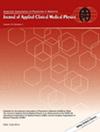Multi-institutional study on image quality for a novel CBCT solution on O-ring linac
Abstract
Introduction
This work presents a multi-institutional study on image quality provided by a novel cone beam computed tomography (CBCT). The main goal is to investigate the consistency of imaging performance across multiple institutions.
Methods
Phantoms for measuring relative electron density (RED) and image quality were sent to six institutions for imaging on Ethos and Halcyon units equipped with HyperSight CBCT. The imaging protocols included tube potential from 100 to 140 kVp and exposure from 80 to 800 mAs. Imaging performance was evaluated with regard to RED versus Hounsfield units (HU), uniformity, contrast-to-noise ratio (CNR), slice thickness, circular symmetry, modulation transfer function (MTF), and spatial resolution.
Results
Among all institutions, some variability was observed among institutions in the RED-to-HU relationship, especially for RED values greater than 1, although no outliers were found (|z-score| < 2 in all cases). In this range, RED/HU slopes were 475 ± 25 10−6 RED/HU at 100kVp, 505 ± 20 10−6 RED/HU at 125kVp, and 550 ± 20 10−6 RED/HU at 140kVp. Radial uniformity ranged from 1 to 7 HU, depending on protocol. Circular symmetry for two points 50 mm apart showed consistency within one-pixel dimension. Integral nonuniformity was between 1 and 10, with no difference observed between vertical and horizontal dimensions. Contrast rods with 1% gave CNR = 0.5, 1 and 2 for 100(88), 125(176), and 140(528) in kVp(mAs), and contrast rods with 0.5% had CNR = 0.2, 0.4 and 0.8 for 100(88), 125(176), and 140(528) in kVp(mAs). Spatial resolution given by MTF at 10% and 50% yielded values of 0.55 ± 0.01 mm−1 and 0.35 ± 0.02 mm−1, respectively.
Conclusions
This multi-institutional analysis of CBCT imaging performance showed consistency in radial uniformity, circular symmetry, integral nonuniformity, contrast, and spatial resolution. Some variability was seen in the RED-to-HU relationship for RED > 1 depending on exposure. More data from different institutions would be necessary to establish more robust statistical metrics, which ensure quality parameters.

 求助内容:
求助内容: 应助结果提醒方式:
应助结果提醒方式:


